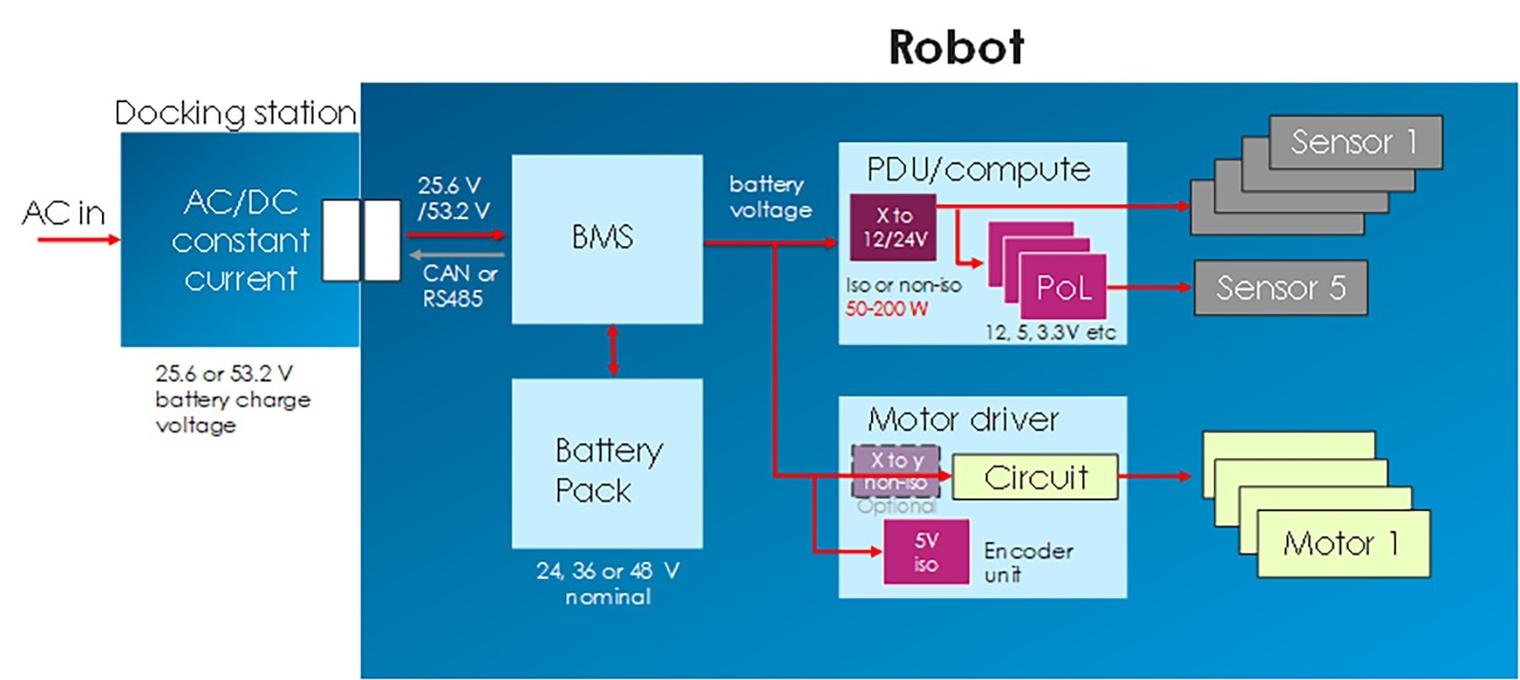The power behind robotics

The robots are coming
We’ve all probably seen videos of the high-profile applications for robots, in car assembly lines, on-line sales distribution centers and remote medical surgery. But they are also increasingly working their way into many other more mundane areas in order to reduce manual labor, such as lawn mowing, cleaning, agriculture and inspection and maintenance. At the same time, robots are taking on the dangerous tasks that we want to avoid, demolition in the construction industry, bomb disposal and search, rescue and security.
Robots that are not ‘tethered’ are categorized as AGVs (autonomous guided vehicles) or the more advanced AMRs (autonomous mobile robots) and the market for them is growing rapidly. This is driven by current labor shortages and costs, and strong e-commerce growth, with its associated manufacturing and logistics operations. According to ‘Interact Analysis’ and ‘IFR World Robotics 2021’ reports, more than 100k AGVs and AMRs were shipped in 2021 into the professional service robotics sector, an increase of 70% over 2020, worth $3bn. By 2025, 640k AMRs alone are expected to be shipped increasingly displacing AGVs. In this category, the applications are dominated by transportation and logistics (Figure 1).

Figure 1: Top five professional service robotics use
This number of shipments, although significant, is spread across many manufacturing SMEs, perhaps around 800 globally with fewer than 500 employees, representing about 80% of suppliers. This means that hardware is often custom built and challenges encountered, particularly in power processing and distribution.
Keeping the robots coming with reliable power
With the wide variety of AGVs and AMRs, there is a similar range of internal power architectures: they are certainly all battery-powered but these could be Li-Ion, Li-Polymer or NiMh at typically 24V, 36V or 48V levels. The robots will normally return to a docking station for re-charging with a simple AC/DC front-end charger with its own noisy supply from other equipment such as motors causing surges, dips and spikes on the AC utility lines. When mobile, the robot’s own internal motors and actuators also generate EMI and the physical environment can be tough and indeterminate, with dust ingress, water, humidity as well as shock and vibration. Up-time is a vital ROI metric and AMRs must be reliably safe around humans as well – no ‘terminators’ here. All this and the hardware must be small, lightweight and cost effective.
Flex has unique insight
Flex has first-hand experience of AMRs starting from about ten years ago with more than 300 installed in the company’s more than 100 locations. Because of this, Flex Power Modules has unique insight into the challenges of providing reliable and cost-effective power for the AMR electronic systems. An intermediate bus architecture is common where the battery voltage is down-converted to a regulated and isolated bus at 12V or 24V, which might be used directly for sensors for example. Sensitive loads such as processors and communications interfaces require lower, precisely regulated voltage rails and these would be provided by point-of-load regulators, most commonly switching types for highest efficiency (Figure 2).

Figure 2: A possible AMR power architecture
Flex Power Modules offers wide-input DC/DCs which are ideal for the bus converter function. For example, the PKB5213D series in an eighth-brick format providing 12 V at 220 W from a wide 18 – 60 VDC input. The product has been configured with a modified input under-voltage lockout to manage the supply dips often encountered in the application, and has been successfully designed in to a robotic factory cleaner for example, where the wide input range, high power density and proven reliability were decisive.
For a lower power rating of 50 W, a sixteenth brick part from the PKU-E series can be used with an even wider input of 18 – 75 VDC, or a part from the PKE series at 30W in a 1” x 1” format.
A point of load converter can be chosen from Flex Power Modules’ PNA, PMU or digital BMR series with programmable outputs down to 0.6 V, current rating up to 18 A and all with high efficiency in LGA/solder bump packages.
Auxiliary supplies are also often needed in AMR applications, for example, for motor control gate drives with voltages matching the drive switch technology, such as IGBTs, Si or SiC MOSFETs. Parts in the Flex Power Modules through-hole PUC-BG and surface-mount PUB ranges are suitable with the bipolar, asymmetric voltages required, along with high isolation up to 6.2 kV and ultra-low coupling capacitance.
Robots need to be looked after
They may not need tea breaks but robots and their power systems need support in initial configuration then a continuous dialog to report status, alarms and performance. This is made easy for the power converters with the Flex Power Designer software with its friendly GUI for initial set up. Additionally, many of the DC/DCs available from Flex Power Modules have data interfaces that can report back in real time, perhaps over 5G in an IIoT environment while the robot is working autonomously.
Flex Power Modules provides the human touch, with comprehensive design-in guidance available, with application notes, data sheets and a global network of engineering support.
You can also view our webinar "Powerful DC/DC solutions for robotics" HERE
